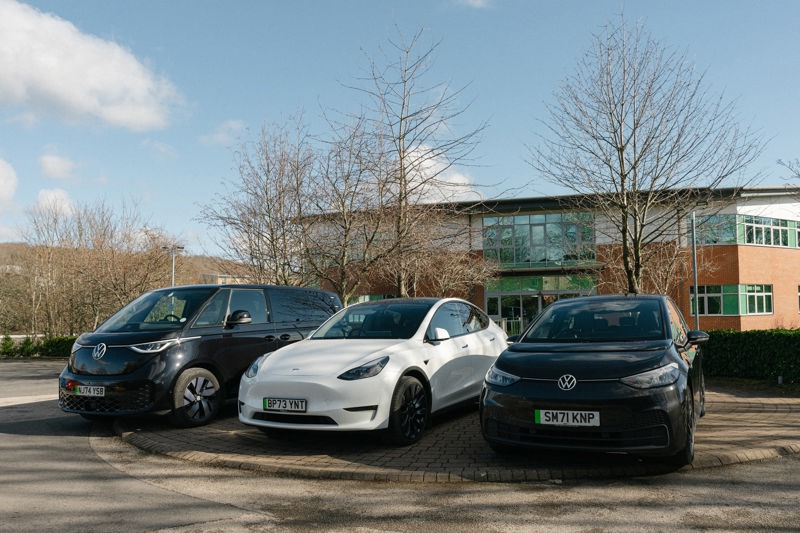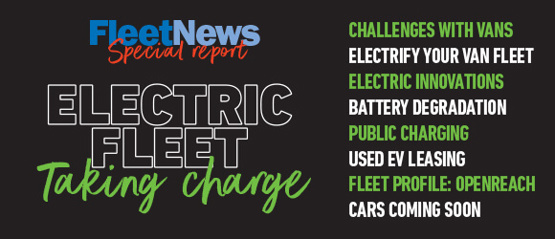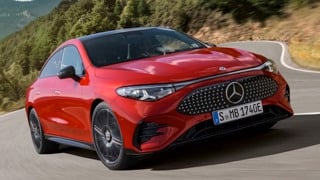This article has been taken from the latest Fleet News special report Electric Fleet: Taking Charge. It is sponsored by Allstar, Athlon, Northgate and Shell Fleet Solutions.

Leasing companies offering used vehicles to customers is a small, but growing, part of their businesses.
Several FN50 companies, such as Lex Autolease, Arval, Ogilvie Fleet and SG Fleet, offer the product although the British Vehicle Rental & Leasing Association (BVRLA) Leasing Outlook report, published in April, shows it accounts for less than 1% of the total BVRLA car lease fleet.
However, there was an 8.5% increase in used car leasing volumes between the third and fourth quarter of 2024, suggesting there is a growing appetite for it.
With these schemes increasingly offering battery electric vehicles, fleets are able to use them to access zero emission vehicles at a lower price than opting for new models.
“Taking on used EVs through Ogilvie’s ReLease is a win-win for us and our drivers; we reduce our impact on the environment, and they often get a vehicle that might not have been available to them if brand new,” says Alan Robertson, senior HR business partner at Gateshead-based workplace technology company Agilco.
Leasing used EVs is proving particularly attractive for smaller businesses and employees seeking a lower-cost route to electrification, says Toby Poston, chief executive of the BVRLA.
“It also aligns with maximising vehicle lifecycles, especially as more first-life EVs become available on the used market,” he adds.
“Used EV programmes present the opportunity to offer lower-cost second-hand electric cars to new segments of price-driven consumers, enabling more to make the switch and improving EV demand across the market.”
Leasing companies are reporting increased interest from organisations.
“The demand so far has been incredibly strong, particularly as businesses are looking for cost-saving solutions in a challenging economic climate,” says Mike Manners, managing director of CBVC Vehicle Management, which is working with Lex Autolease to ensure a supply of used EVs.
Chris Salmon, commercial director at SG Fleet, adds: “In a world where cars and vans are costing a lot more to renew than their existing leases – due to inflation, reduced discounts and increased taxation among other factors – running used vehicles, potentially to an older age than has traditionally been the case, is being used by more and more customers especially on internal combustion engine (ICE) light commercial vehicles (LCVs).
“Furthermore, they are using it as a way to access EVs – usually through salary sacrifice but potentially also through company car schemes – without the same cost and duration commitment a new vehicle would command.”
Jo Clark, director of sales at Ogilvie Fleet, echoes this sentiment while highlighting other benefits.
“It’s particularly effective when overall costs are rising, but companies are reluctant to increase banding limits,” she adds.
“It allows ICE drivers to switch into EVs quickly, reducing benefit-in-kind (BIK) tax for drivers and lowering total cost of ownership for the business.
“It’s also great for companies who have overseas employees working in the UK for 12 or 24 months. “Many clients are using it to support their sustainability goals, and drivers benefit from access to higher-grade vehicles than they might otherwise be able to afford.
“It’s a flexible alternative to daily rental for shorterterm needs, and we’ve also seen strong uptake through salary sacrifice, with drivers often able to access higher-spec vehicles within their budget.”
Tusker offers used EVs through its salary sacrifice schemes, with its managing director Kit Wisdom saying a used sal/sac lease could be anywhere up to 20% cheaper.
“It really depends on the make, the model and what the cost of a new car is at that particular moment in time,” he adds.
This lower cost for two- to three-year-old EVs allows employees to enter a sal/sac scheme sooner than they might otherwise have been able to, says Cheryl Clements, head of business development at Tusker.
“We’re seeing more people wanting to offer pre-loved salary sacrifice vehicles to help those vehicles back on the road and widen the opportunity of driving an EV to even more people,” she adds.
Leasing companies are witnessing the popularity of used EVs grow “month on month”.
As awareness increases of their cost and tax efficiencies, as well as the environmental benefits, they expect to see even wider adoption of used EVs.
“Fleets have historically been very cost-driven and, basically, it’s less expensive to drive a used EV than a new one,” explains Clements.
“With costs going up, it will become more of a consideration for fleets which want to offer a wider range of vehicles, while keeping costs low.”
Clark also suspects that used EV leasing will become “a more prominent option” within fleet strategies moving forward.
“It’s particularly compelling for situations where traditional leasing wasn’t previously viable or where long-term daily rental was the norm,” she says.
SG Fleet’s Salmon asserts the only threat to the uptake of used EVs by fleets will occur if new vehicle discounts and list prices improve to the d new one isn’t sufficiently significant.
“But I do think the absence of potentially troublesome mechanical parts does make used EV leasing an increasingly viable option,” he adds.
Supply of EVs into the used leasing market will also increase as more reach the end of their initial lease terms, improving affordability and choice.
“Policy and tax incentives are also driving employer and employee interest, particularly via salary sacrifice schemes,” says Poston.
“More can be done in this space though as the incentives are targeted exclusively at new vehicles.
“For example, a dedicated BIK rate for used EVs will realign the incentive and drive further demand. But, as fleet managers grow more confident in EV performance and battery longevity, used EVs will become an integral part of fleet electrification strategies.”
Vehicle condition
Most used EVs being offered to fleets tend to be vehicles which have primarily been returned either at the end of an existing contract or through early termination from corporate or sal/sac schemes.
This means the company offering the used vehicles should have a complete picture of their history, including maintenance and condition.
“As we know the servicing has been completed and the battery has been looked after throughout its ‘first life’ with us, if there had been any issues with the car, we wouldn’t be offering it as a pre-loved vehicle,” says Clements.
As a general rule, all vehicles offered are in a condition which complies with BVRLA guidelines or better.
“Our used EVs are ex-lease cars while the LCVs are a mix of ex-lease vehicles and pre-registered or ex-demo with less than 12-months’ usage that have been drawn from our dealer network,” says Salmon.
“Condition-wise, they are brought up to either ‘as new’ or acceptable according to customer standards.”
Tusker’s customer service policy dictates that all wear and tear should be detailed fully right from the start.
“These are real cars that customers are considering and we want them to know of any flaws, so they don’t have any surprises at delivery,” adds Clark.
Benefits for leasing companies
Offering used EV leasing also has business advantages for leasing companies.
As well as increasing their portfolio of products, it can help them mitigate financial losses on used EVs, both from standard defleets and early terminations given the current volatility of EV residual values (RVs).
“These schemes also contribute to faster progress towards our sustainability goals by extending the lifecycle of EVs and encouraging wider adoption across fleets,” says Clark.
However, Clements adds that – from a provider’s perspective – used vehicle leasing is substantially more “manual” when compared with leasing a new vehicle.
This is due to the problems inherent when it comes to setting RVs and maintenance costs due to this being individual to each car and not easily scalable.
“For context, it’s far more complex to operate used vehicle leasing quotations than it is to operate new vehicle leasing,” says Clements.
“With new vehicles, everyone begins at the same starting point for price and quotation systems can have pre-loaded residual and maintenance information.”
In response to this challenge, Tusker created its own scalable, online technology where people can get an immediate quote for used cars, which also have photos included.
“We’ve powered far beyond the norm of creating manual quotes and our customers can now see a used car like they’re in an online showroom – just like they do with a brand-new vehicle,” adds Clements.
“We’ve done this because there’s a transparency issue with used lease vehicles.
“The challenge felt across the industry is that customers can’t usually see the cars, so they think they should be getting a car that’s brand-new quality even though it’s been driven for a few thousand miles.”
With the ban on the sale new petrol or diesel vehicles just one or two replacement cycles away, transitioning to an electric fleet is at the top of the agenda for the majority of fleet decision-makers.
But the switch to the zero-emission technology is fraught with obstacles – especially for van operators who face legislative issues as well as vehicle suitability and charging.
In out new Electric Fleet: Taking Charge report, we look in detail about how you can start the journey to van electrification and speak to those already well advanced in their transition about the innovative ways in which they overcome some of the problems.
Employing industry experts and scientific research, we also bust some myths about batteries – spoiler alert, the average level of degradation at 1.8% a year is much lower than many predicted - and look at the technologies poised to come to market promising greater range and faster charging.
The report is sponsored by Allstar, Athlon, Northgate and Shell Fleet Solutions.






















Login to comment
Comments
No comments have been made yet.